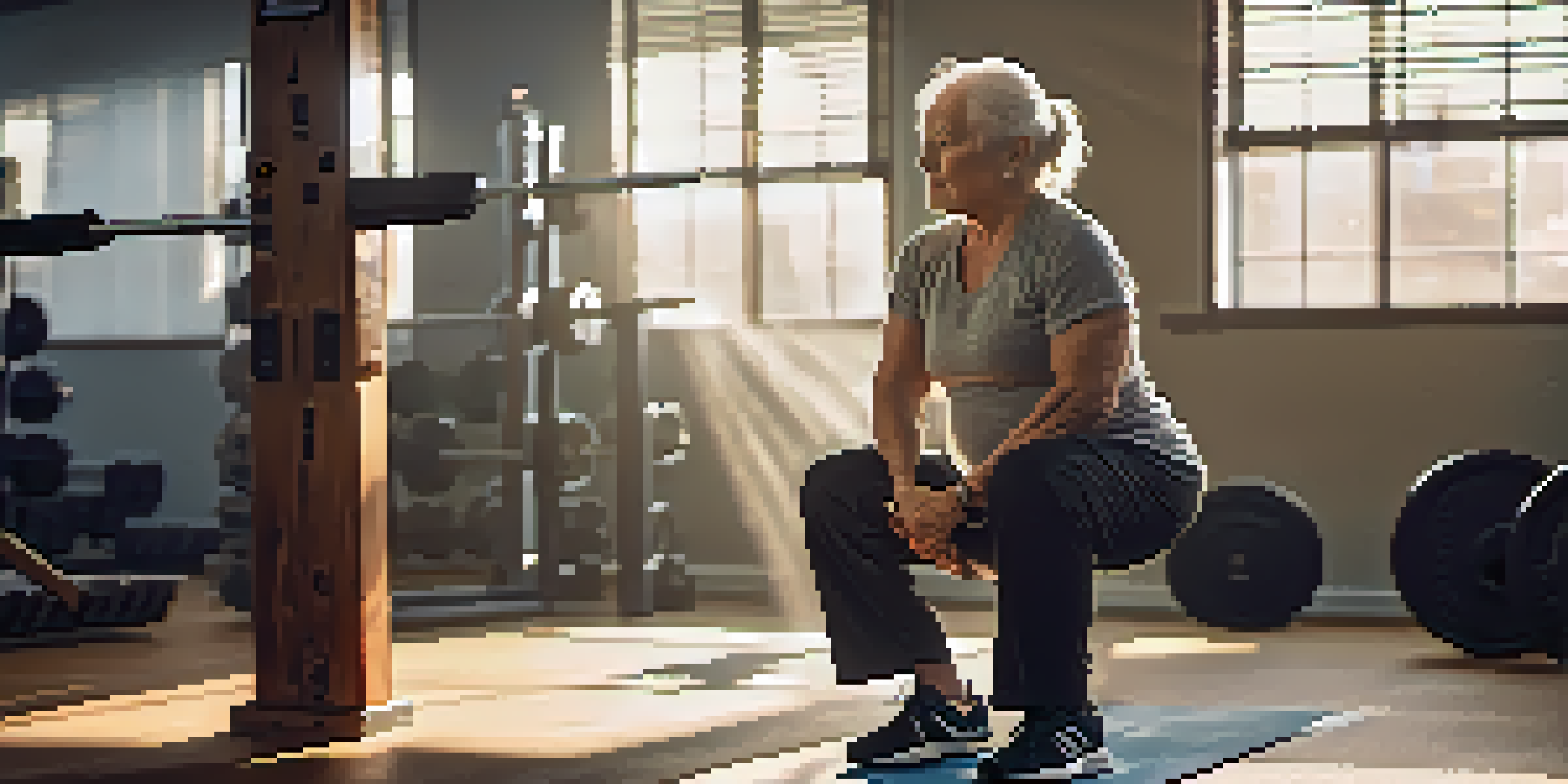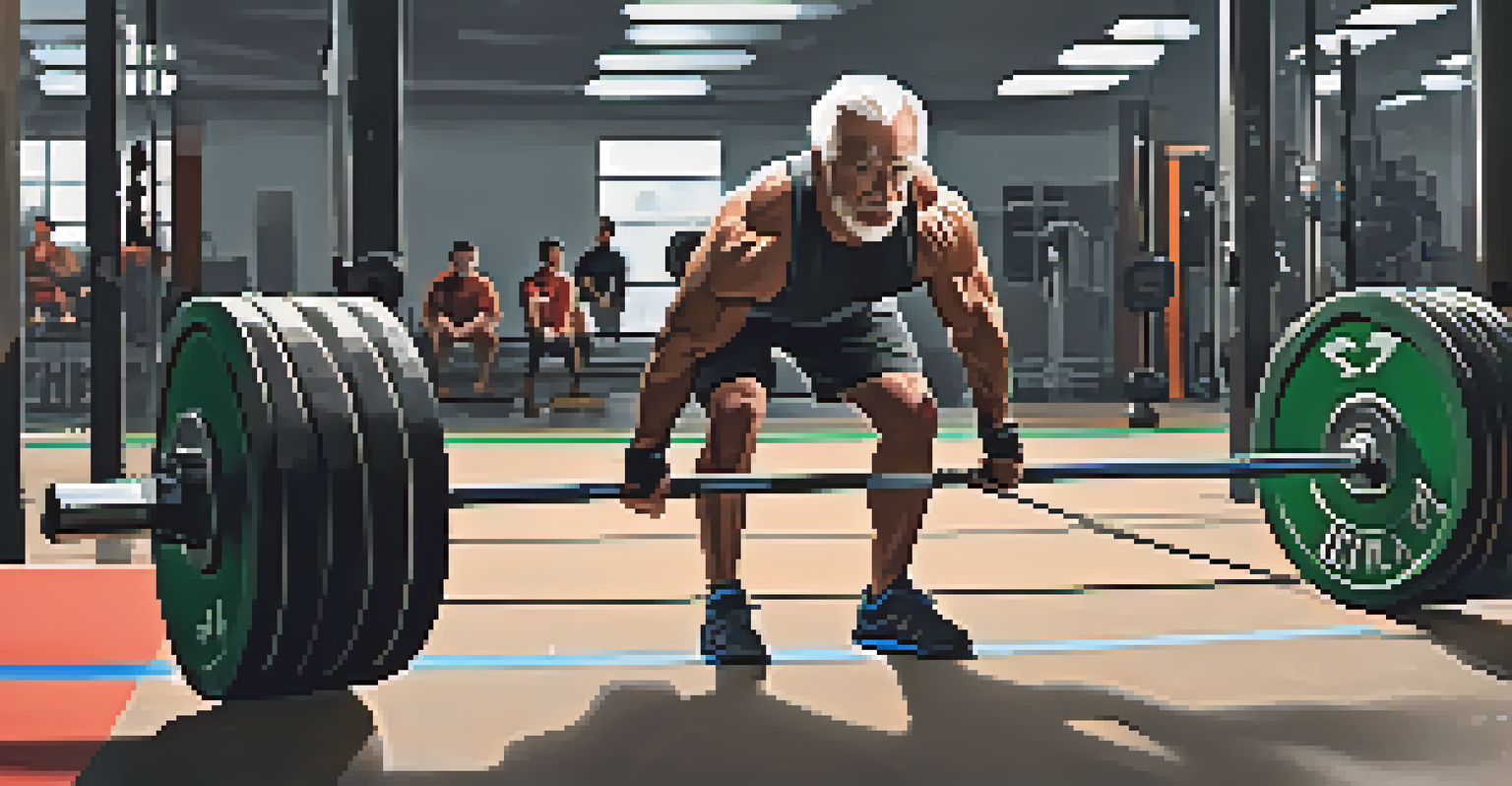Powerlifting Techniques for Older Adults: A Beginner's Guide

Understanding Powerlifting Basics for Older Adults
Powerlifting is a strength sport focusing on three main lifts: the squat, bench press, and deadlift. For older adults, understanding these basics is crucial, as they provide a strong foundation for safe practice. It’s important to emphasize that powerlifting isn’t just for young athletes; with the right approach, older adults can enjoy its benefits too.
Strength does not come from physical capacity. It comes from an indomitable will.
The primary goal of powerlifting is to lift the maximum weight possible in each of these three exercises. However, older adults should prioritize form and technique over heavy weights, ensuring they build strength without risking injury. This means starting with lighter weights and gradually increasing as confidence and ability grow.
Adopting a beginner-friendly mindset is key. Approach powerlifting as a journey rather than a competition. By setting personal goals and celebrating small victories, older adults can stay motivated and engaged in their training.
Benefits of Powerlifting for Older Adults
Powerlifting offers numerous benefits for older adults, including increased muscle strength, improved bone density, and enhanced functional fitness. As we age, maintaining muscle mass and bone health becomes increasingly important, and powerlifting can play a significant role in this. Engaging in regular strength training helps combat the natural decline in muscle and bone density that occurs with age.

Moreover, powerlifting can boost mental well-being. The sense of accomplishment from lifting weights can enhance self-esteem and reduce feelings of anxiety or depression. Additionally, the discipline of training and commitment to a routine can provide structure and purpose, which is especially valuable as we age.
Powerlifting Benefits for Seniors
Powerlifting helps older adults build strength, improve bone density, and enhance mental well-being.
Another important aspect is social interaction. Joining a powerlifting community or class can create connections with like-minded individuals. This camaraderie can lead to friendships and a support system that encourages ongoing participation in physical activity.
Essential Warm-Up Techniques for Safety
Warming up is a crucial step for anyone engaging in powerlifting, especially older adults. A proper warm-up increases blood flow to muscles, enhances flexibility, and prepares the body for heavier lifts. Simple activities like dynamic stretching or light cardio can effectively raise your heart rate and loosen up the joints.
Aging is not lost youth but a new stage of opportunity and strength.
Incorporating mobility exercises into your warm-up routine can greatly benefit older adults. Movements like leg swings, arm circles, and gentle squats can promote joint health and improve overall flexibility. Focusing on areas that may be tight or stiff, such as hips and shoulders, can further enhance your lifting performance.
Lastly, always listen to your body during warm-ups. If something doesn’t feel right or causes discomfort, it’s essential to adjust your routine accordingly. Being attentive to your body’s signals can prevent injuries and ensure a more enjoyable lifting experience.
Choosing the Right Powerlifting Equipment
Selecting the right equipment is essential for older adults who are new to powerlifting. Start with a good pair of lifting shoes that provide stability and support. These shoes can be a game-changer, as they help maintain proper form and reduce the risk of slips or falls during lifts.
Another important piece of equipment is a weightlifting belt. While not necessary for everyone, a belt can provide extra support for the lower back during heavy lifts. For beginners, it’s best to use a belt only when lifting significant weights, focusing instead on mastering technique initially.
Safe Technique is Essential
Prioritizing proper form and starting with lighter weights is crucial for older adults to avoid injuries while powerlifting.
Lastly, consider investing in wrist wraps and knee sleeves. These accessories can offer additional support and protection to joints, particularly during heavier lifts. However, they should complement, not replace, proper lifting technique and strength training.
Mastering the Squat: Key Techniques to Learn
The squat is one of the foundational lifts in powerlifting and is excellent for building lower body strength. To start, stand with your feet shoulder-width apart, keeping your chest up and core engaged. As you lower yourself, push your hips back and bend your knees, ensuring they track over your toes to maintain proper form.
For older adults, using a chair or box to practice squats can be beneficial. This approach helps gauge depth and provides support if balance is an issue. Gradually, as confidence grows, you can transition to bodyweight squats and eventually to weighted squats, focusing on maintaining proper alignment throughout.
Remember, it’s essential to listen to your body. If you experience discomfort or pain while squatting, reassess your form or reduce the weight. Working with a coach or knowledgeable partner can provide valuable feedback and guidance as you master this lift.
Perfecting the Bench Press Technique
The bench press is another core lift in powerlifting that targets the upper body. To perform it safely, start by lying flat on the bench with your feet planted firmly on the ground. Your grip should be slightly wider than shoulder-width, and always keep your elbows tucked at about a 45-degree angle from your body.
For older adults, using a lighter weight at first is key. Focus on controlled movements and ensure you have a spotter or use a safety rack when lifting heavier weights. This added safety measure allows you to push yourself without the fear of being pinned under the bar, which can be particularly concerning for beginners.
Effective Warm-Up Techniques
A proper warm-up, including mobility exercises, is vital for older adults to prepare their bodies for powerlifting safely.
Lastly, incorporating variations like incline or decline bench presses can enhance your strength training regimen. These variations target different muscle groups and can help prevent boredom in your workouts, keeping you engaged and motivated.
Safe Deadlifting Techniques for Beginners
Deadlifting is a powerful exercise that works multiple muscle groups, but proper technique is crucial, especially for older adults. Start by standing with your feet hip-width apart, with the barbell positioned over the middle of your feet. As you grip the bar, keep your back straight, engage your core, and push through your heels as you lift.
To minimize the risk of injury, consider starting with a lighter weight or even a kettlebell. Practicing the deadlift movement without heavy weights helps you focus on form and build strength gradually. This approach allows you to become comfortable with the mechanics of the lift before progressing.

Incorporating variations like the sumo deadlift can also be beneficial. This variation uses a wider stance and can be easier on the lower back, making it a great option for older adults looking to build strength safely.
Creating a Balanced Powerlifting Routine
A well-rounded powerlifting routine is essential for older adults aiming to build strength safely. This routine should include all three main lifts—squat, bench press, and deadlift—along with accessory exercises that target different muscle groups. Incorporating exercises like lunges, rows, and overhead presses can enhance overall strength and balance.
Additionally, consider the frequency of your workouts. For beginners, two to three sessions per week is often sufficient to see progress. Ensure that you allow rest days in between sessions, giving your muscles time to recover and grow stronger.
Lastly, remember that consistency is key. Tracking your progress and making adjustments to your routine as you advance can keep you motivated. Celebrate your achievements, no matter how small, and enjoy the journey of strength building.